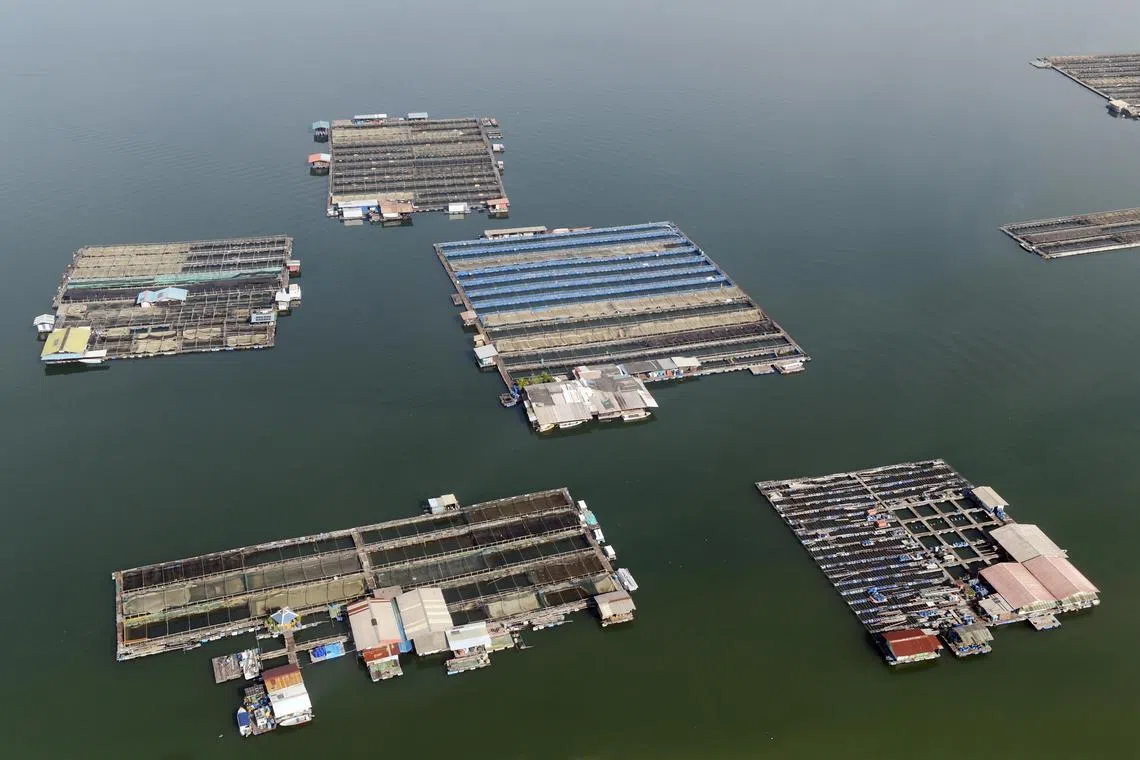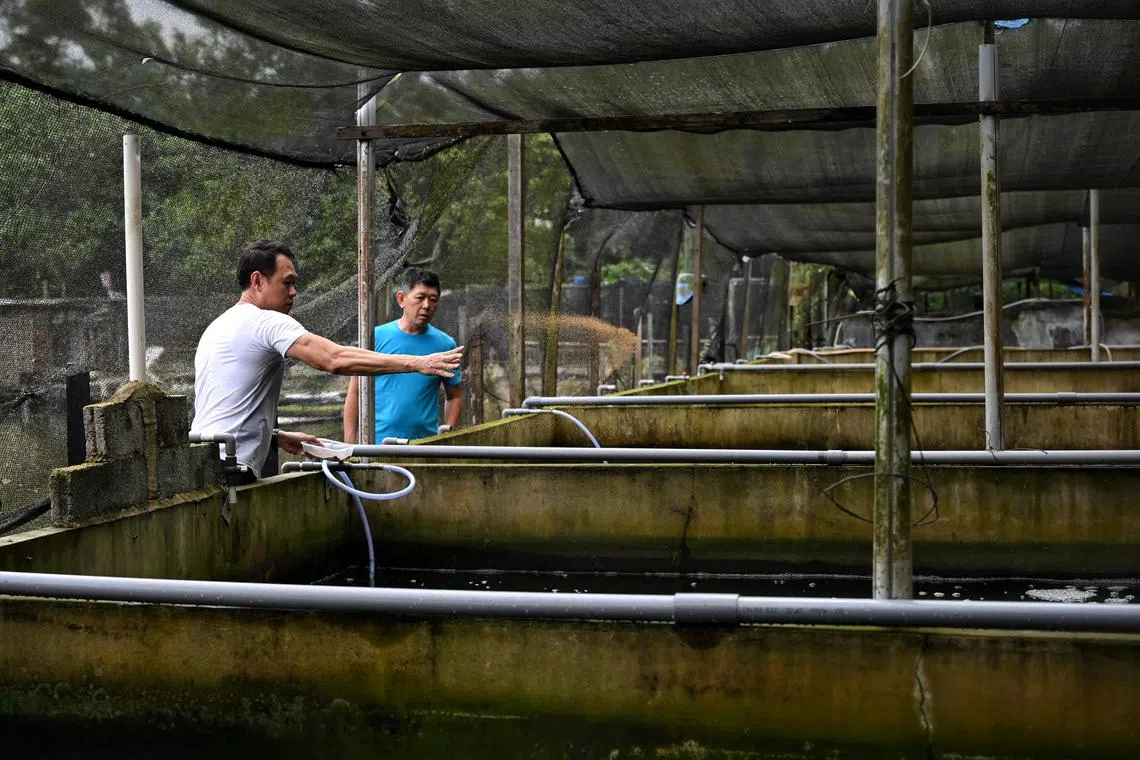A quarter of fish farms shut down in past year, some of which took up $100,000 SFA support package
Sign up now: Get ST's newsletters delivered to your inbox

All of the sea-based fish farms currently in operation in Singapore are located in the Johor Strait. But farmers have expressed concern about deteriorating water quality.
PHOTO: ST FILE
Follow topic:
SINGAPORE – About a quarter of Singapore’s sea-based fish farms have exited the industry over the past year, with some farm operators saying they had accepted a financial support package from the authorities to wind up operations.
Singapore Food Agency (SFA) figures showed that there were 74 sea-based fish farms in October 2024, down from 98 in 2023, according to its 2023 food statistics report. Between 2019 and 2022, the number of sea-based fish farms held steady at about 110.
At least five fish farm operators that The Straits Times spoke to said they were offered a support package from SFA to ease the financial burden of winding up their operations.
Farmers said they had a year – between July 2023 and June 2024 – to take up the package to help them reinstate the sea space their farms occupied.
ST has asked SFA how many farmers accepted this package, which amounted to up to $100,000.
The support package comes as sea-based fish farms in Singapore are being transitioned to a new sea space management model by the SFA, which the agency announced in 2022.
Farms will have to pay for the use of sea spaces under the new scheme, which took effect in 2024. They did not have to previously.
For fish farm operators, this means that the cost of maintaining a farm is expected to increase, with farms set to pay $3,600 per year to use half a hectare of sea space from 2026, in addition to a $145 annual farm licence fee.
Farmers are currently paying 20 per cent of the $3,600 fee in 2024, and will pay 50 per cent in 2025, to mitigate the impact of the increase.
Those who opted for the support package cited factors such as higher costs and changing environmental conditions that could impact yield. Some also decided to retire.
Mr Joseph Wee, owner of Aquablue, a farm that reared grouper and lobster, told ST that he shut down his farm in the East Johor Strait in June 2024, after taking up a $100,000 support package from SFA.
Mr Wee, 63, said about 30 per cent of the entire sum was disbursed before the reinstatement of his farm’s space – which refers to demolishing existing structures there – while the remainder was given after the demolition was completed.
Farmers said they were required to engage marine scanning services to ensure no infrastructural debris had been left on the seabed.
Mr Wee, who had been farming for about 15 years, said he spent around $40,000 on disposing of his farm and the surveys, allowing him to pocket the remaining $60,000 as retirement savings.
He said he decided to retire when the offer came along because of high labour costs and the significant level of investments needed to maintain the farming structures over the years.
“As the farming structures are made from wood, these would slowly deteriorate over the years, after being exposed to the seawater and rain, and need constant repair and maintenance,” said Mr Wee.
He had initially planned to sell his farm and transfer the licence to the buyer, but said SFA did not allow this.
“This leaves us with no choice but to either bite the bullet and continue farming, or shut down our farm and exit the industry,” he added.
SFA had told ST that the Government provided farmers who chose to exit the industry with support to reinstate their farm space, as well as job-matching and training for those who opted for a career switch.
Some farmers said it has been difficult to profitably meet SFA’s annual minimum productivity levels of 17 tonnes per half hectare of sea space they occupy.
SFA said such requirements have been part of the licensing conditions since the 1990s, and are in place due to space constraints.
The agency added that it will support farmers who are keen to increase productivity, by providing account managers to assist and advise them, as well as through funding support for technology adoption.
All of the sea-based fish farms currently in operation in Singapore are located in the Johor Strait – the narrow body of water between Singapore and Malaysia.
But farmers have expressed concern about deteriorating water quality, due to surrounding industrial activity, port operations, and nutrient build-up over the years, causing harmful algae blooms that can kill hundreds of fish at one go.
ST had reported in 2020
Mr Wee recalled enduring two significant “red tides” over the years, caused by algae blooms which brought about widespread fish deaths, costing him significant financial losses.
But at least two fish farmers are opting to stay put.
Heng Heng Fish Farm co-owner Alvin Yeo, 35, said he intends to continue the family business by farming tilapia, a more sustainable food fish than the milkfish the farm used to grow. This is because milkfish are often fed expired bread and other confectionery, which pollute the waters.
“We don’t know if the lease will end up becoming way too expensive compared with the amount that we currently pay on a yearly basis, and if it does, it will end up being unsustainable for us to continue farming,” he said.
Farming tilapia has also allowed the farm to tap an existing initiative that helps to connect farmers to large retailers like FairPrice and wet markets, said Mr Yeo, providing more impetus for him to stay.
The Singapore Agro-Food Enterprises Federation (Safef) aggregates marine tilapia – of at least 400g in weight – from some nine local fish farms and hatcheries so far, and sells the fish under the brand name of The Straits Fish.
Mr Joe Ng from Century Aquaculture, who breeds tilapia fingerlings, or baby fish, said that he has seen demand increase for his fish in recent months because of the Safef initiative.
The hatchery currently breeds its own marine tilapia species and produces some 100,000 to 150,000 fingerlings a month, which are supplied to around five or six farms, mostly in the waters off Lim Chu Kang.

Century Aquaculture’s managing director Joe Ng (left) with sales director Francis Tan. Mr Ng said he has seen demand increase for his fish in recent months, thanks to Safef’s initiative.
ST PHOTO: KUA CHEE SIONG
Mr Ng expects demand to grow further in the coming months, and will be scaling up operations to produce some 500,000 fingerlings monthly.
Mr Daniel Tay from Straits Seafood said the Safef initiative has given him a lifeline. Instead of taking up the $100,000 support package, he is revamping operations to produce tilapia at the scale needed.
For instance, the farm now regularly tracks fish growth and monitors the prevalence of disease, with the help of aquaculture consultant AquaFarms Advisors.
“We used to farm species like the Asian sea bass and red snapper, but production was not consistent due to the lack of sufficient demand,” he added.
The farm had also suffered a dip in sales every time fish prices in Malaysia dropped, he said.
“Now, with a guaranteed buyer as long as we adhere to good aquaculture practices, there’s a future for fish farming,” he added.

